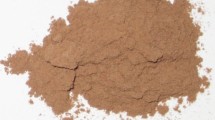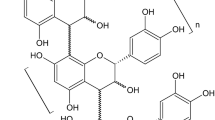Abstract
Increasing demand for wood based panel products and shortage of wood as raw material have triggered many efforts to utilize residues generated annually by the forest industries including a large portion of bark in panel production. In this study, the effects of using bark flours as additives obtained from different wood species (walnut, chestnut, fir and spruce), having much polyphenol content, on some physical and mechanical properties and formaldehyde emission of plywood panels were examined. Wheat flour, which has been used widely as additive in plywood manufacturing, served as control. Plane tree (Platanus orientalis) logs were obtained for veneer manufacturing. Urea formaldehyde (UF) resin with 55 % solids content was used as adhesive. The bonding shear strength, bending strength, modulus of elasticity (MOE), density, equilibrium moisture content and formaldehyde emission of plywood panels were determined according to related standards. It was found that the use of flours obtained from the barks of chestnut and fir trees in the glue mixture decreased the formaldehyde emission of panels. The bonding strength values of the test panels made using the glue mixture including the flour of walnut and spruce barks as additive were lower than those of the panels with adhesive containing the flour of fir and chestnut barks. The panels manufactured with adhesives including the flour of fir bark gave the highest bending strength and modulus of elasticity values.



Similar content being viewed by others
References
Anderson AB, Wong A, Wu KT (1974) Utilization of white fir bark and its extract in particleboard. Forest Prod J 24(7):40–44
Blanchet P, Cloutier A, Reidl B (2000) Particleboard made from hammer milled black spruce bark residues. Wood Sci Technol 34:11–19
Cetin NS, Ozmen N, Narlioglu N, Cavus V (2014) Effect of bark flour on the mechanical properties of HDPE composites. Usak University Journal of Material Sciences 1:23–32
Colakoglu G, Kalaycioglu H, Ors Y (1993) Utilization of the bark of Turkish red pine on particleboard and plywood manufacturing. International Red Pine Symposium, Proceedings, October 18-23, Marmaris, Turkey, pp.701-710
Derkyi NSA, Sekyere D, Darkwa NA (2014) Effect of Extraction Solvent on Tannin-Formaldehyde Adhesives for Plywood Production. JENRM 1(2):120–126
Eberhardt TL, Reed KG (2007) Strategies for improving the performance of plywood adhesive mix fillers from southern yellow pine bark. Forest Prod J 56(10):64–68
Elbadawi M, Osman Z, Paridah T, Nasroun T, Kantiner W (2015) Mechanical and physical properties of particleboards made from Ailanthus wood and UF resin fortified by Acacias tannins blend. J. Mater. Environ. Sci. 6(4):1016–1021
EN 310 (1993) Wood based panels - Determination of modulus of elasticity in bending and of bending strength. European standard
EN 314-1 (1993) Plywood - Bonding quality - Part 1: Test methods. European standard
EN 322 (1993) Wood-based panels- Determination of moisture content. European standard
EN 323-1 (1993) Wood- Based panels- Determination of density. European standard
EN 717-3 (1996) Wood-Based panels- Determination of formaldehyde release Part 3: Formaldehyde release by the flask method. European standard
Gupta GK (2009) Development of bark-based environmental-friendly composite panels. Faculty of Forestry, University of Toronto, Master of Science in Foresty
Hafizoglu H, Holmbom B (1995) Chemical composition of extractives from Abies nordmanniana. Holz Roh- Werkst 53:273–275
Hafizoglu H, Usta M, Bilgin Ö (1997) Wood and Bark Composition of Picea orientalis (L.) Link. Holzforschung 51:114–118
Hoong YB, Paridah MT, Loh YF, Koh MP, Luqman CA, Zaidon A (2010) Acacia mangium tannin as formaldehyde scavenger for low molecular weight phenol-formaldehyde resin in bonding tropical plywood. J Adhes Sci Technol 24:1653–1664
Jahanshaei S, Tabarsa T, Asghari J (2012) Eco-friendly tannin-phenol formaldehyde resin for producing wood composites. Pigm Resin Technol 41(5):296–301
Kim S, Lee YK, Kim HJ, Lee HH (2003) Physico-mechanical properties of particleboards bonded with pine and wattle tannin-based adhesives. J Adhes Sci Technol 17(14):1863–1875
Kim JS, Eom YG, Kim S, Kim HJ (2007) Effects of natural-resource-based scavengers on the adhesion properties and formaldehyde emission of engineered flooring. J Adhes Sci Technol 21(3–4):211–225
Krisper P, Tišler V, Skubic V, Rupnic I, Kobal S (1992) The Use of Tannin from chestnut, plant polyphenols synthesis, properties. Significance 59:1013–1019
Lelis R, Roffael E (1995) Über die Reaktivität von Douglasiensplint- und -kernholz und deren Heisswasserextrakte gegenüber Formaldehyd (On the reactivity of sap- and heartwood of Douglas fir as well as their water extractives towards formaldehyde) (In German) Holz Roh- Werkst 53: 12–16
Marutzky R (1994) Release of formaldehyde by wood products. Chapter 10. In: Wood adhesives-chemistry and technology. Vol. 2. Pizzi A. (eds) Marcel Dekker, Inc., New York and Basel
Mikolojczak E (2011) Possibilities of utilizing wood biomass. Transfer Inovacii 19:26–29
Muszynski Z, McNatt JD (1984) Investigation on the use of spruce bark in the manufacture of particleboard in Poland. Forest Prod J 34(1):28–38
Nemli G, Colakoglu G, Colak S, Aydin I (2002). Effects of log storage time and bark usage ratio on the formaldehyde emission of particleboard manufactured from black locust (Robinia pseudoacacia L.). Faculty For J Istanbul Univ Ser A 52(2):72–83
Nemli G, Kırcı H, Temiz A (2004) Influence of impregnating wood particle with mimosa bark extract on some properties of particleboard. Ind Crops Prod 20:339–344
Pizzi A, Valenezuela J, Westermeyer C (1994) Low formaldehyde emission, fast pressing, pine and pecan tannin adhesives for exterior particleboard. Holz Roh-Werkst 52:311–315
Roffael E (1982) Die Formaldehydabgabe von Spanplatten und anderen Werkstoffen, (Formaldehyde release of particleboard and various wood-based product) (In German) DRW-Verlag, Stuttgart
Roffael E, Dix B, Okum J (2000) Use of spruce tannin as a binder in particleboards and medium density fiberboards (MDF). Holz Roh- Werkst 58:301–305
Sahin HT, Arslan MB (2011) Weathering performance of particleboards manufactured from blends of forest residues with red pine (Pinus brutia) wood. Maderas Ciencia y tecnologia 13(3):337–346
Sakai K (2001) Chemistry of bark, Wood and cellulosic chemistry, Chapter 7, Second Edition, Markel Dekker, Inc., 270, Madison
Sellers T, Miller GD, Smith W (2005) Tool wear properties of five extender/fillers in adhesive mixes for plywood. Forest Prod J 55(3):27–31
Tišler V (1991) Spruce tannin in specialty application, Proceedings of the second north american tannin conference on plant polyphenols: synthesis, properties, Significance, 17–21, Houghton, Michigan
URL1 (2014) Adhesive filler and extender. http://adhesive.health-tips-diseases.com/2009/11/adhesive-filler-and-extender.html. Accessed 18 December 2014
URL2 (2014) Fillers and extenders. http://adhesive-formula.blogspot.com/2008/05/fillers-and-extenders.html. Accessed 18 December 2014
Vázquez G, Antorrena G, González J, Alvarez JC (1996) Tannin-based adhesives for bonding high-moisture eucalyptus veneers: influence of tannin extraction and press conditions. Holz Roh-Werkst 54(2):93–97
Yazaki Y, Collins PJ (1994) Wood adhesives based on tannin extracts from barks of some pine and spruce species. Holz Roh-Werkst 52(5):307–310
Acknowledgments
Some results of this study were presented at the Third National Karadeniz Forestry Congress held in Artvin Coruh University, Artvin, 2010.
Author information
Authors and Affiliations
Corresponding author
Rights and permissions
About this article
Cite this article
Aydin, I., Demirkir, C., Colak, S. et al. Utilization of bark flours as additive in plywood manufacturing. Eur. J. Wood Prod. 75, 63–69 (2017). https://doi.org/10.1007/s00107-016-1096-0
Received:
Published:
Issue Date:
DOI: https://doi.org/10.1007/s00107-016-1096-0




